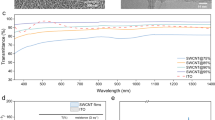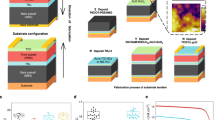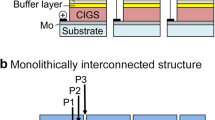Abstract
Bifacial Cu(In,Ga)Se2 (CIGS) solar cells are attractive for a range of applications, but their low power conversion efficiency is a limitation. To improve their efficiency, the formation of GaOx at the CIGS/transparent-conducting-oxide interface and charge recombination near this interface under rear illumination need to be suppressed. In the study reported here we prevented the formation of GaOx by silver-promoted low-temperature growth of the CIGS layer. This process also led to an improvement in the absorber quality, a steep Ga gradient near the back interface and reduced the absorption of the transparent conducting oxide. We also report here a certified bifacial solar cell on a glass substrate with efficiencies of 19.77% and 10.89% under front and rear illumination, respectively. We also fabricated bifacial solar cells directly on flexible substrates. Finally, we prepared bifacial perovskite/CIGS tandem solar cells in a four-terminal configuration, achieving a power generation density of 28.0 mW cm-2 under 1 Sun and 30% albedo illumination.
This is a preview of subscription content, access via your institution
Access options
Access Nature and 54 other Nature Portfolio journals
Get Nature+, our best-value online-access subscription
$29.99 / 30 days
cancel any time
Subscribe to this journal
Receive 12 digital issues and online access to articles
$119.00 per year
only $9.92 per issue
Buy this article
- Purchase on Springer Link
- Instant access to full article PDF
Prices may be subject to local taxes which are calculated during checkout







Similar content being viewed by others
Data availability
All the data generated or analysed during this study are included in the published article and its Supplementary Information. Source data are provided with this paper.
References
Figueres, C. et al. Three years to safeguard our climate. Nature 546, 593–595 (2017).
Victoria, M. et al. Solar photovoltaics is ready to power a sustainable future. Joule 5, 1041–1056 (2021).
Solar PV power generation in the Net Zero Scenario, 2000–2030. IEA https://www.iea.org/data-and-statistics/charts/solar-pv-power-generation-in-the-net-zero-scenario-2000-2030 (2021).
Hanmandlu, C. et al. Bifacial perovskite solar cells featuring semitransparent electrodes. ACS Appl. Mater. Interfaces 9, 32635–32642 (2017).
Jouttijärvi, S., Lobaccaro, G., Kamppinen, A. & Miettunen, K. Benefits of bifacial solar cells combined with low voltage power grids at high latitudes. Renew. Sustain. Energy Rev. 161, 112354 (2022).
Katsikogiannis, O. A., Ziar, H. & Isabella, O. Integration of bifacial photovoltaics in agrivoltaic systems: a synergistic design approach. Appl. Energy 309, 118475 (2022).
Kopecek, R. & Libal, J. Towards large-scale deployment of bifacial photovoltaics. Nat. Energy 3, 443–446 (2018).
Kopecek, R. & Libal, J. Bifacial photovoltaics 2021: status, opportunities and challenges. Energies 14, 2076 (2021).
International Technology Roadmap for Photovoltaic (ITRPV)—Results 2017 ITRPV and VDMA http://www.pvmen.com/upload/attachment/201803/20/053037/ITRPV%20Ninth%20Edition%20Presentation%202018.pdf (2018).
Nakamura, M. et al. Cd-free Cu(In,Ga)(Se,S)2 thin-film solar cell with record efficiency of 23.35%. IEEE J. Photovolt. 9, 1863–1867 (2019).
Carron, R. et al. Heat-light soaking treatments for high-performance CIGS solar cells on flexible substrates. Preprint at https://doi.org/10.21203/rs.3.rs-2116168/v1
Shin, M. J. et al. Semitransparent and bifacial ultrathin Cu(In,Ga)Se2 solar cells via a single-stage process and light-management strategy. Nano Energy 82, 105729 (2021).
Nakada, T., Hirabayashi, Y., Tokado, T., Ohmori, D. & Mise, T. Novel device structure for Cu(In,Ga)Se2 thin film solar cells using transparent conducting oxide back and front contacts. Sol. Energy 77, 739–747 (2004).
Heinemann, M. D. et al. Cu(In,Ga)Se2 superstrate solar cells: prospects and limitations. Prog. Photovolt. 23, 1228–1237 (2015).
Son, Y.-S. et al. Control of structural and electrical properties of indium tin oxide (ITO)/Cu(In,Ga)Se2 interface for transparent back-contact applications. J. Phys. Chem. C 123, 1635–1644 (2019).
Keller, J. et al. Using hydrogen-doped In2O3 films as a transparent back contact in (Ag,Cu)(In,Ga)Se2 solar cells. Prog. Photovolt. 26, 159–170 (2018).
Nishimura, T. et al. Device design for high-performance bifacial Cu(In,Ga)Se2 solar cells under front and rear illuminations. Sol. Energy 218, 76–84 (2021).
Chen, L., Lee, J. & Shafarman, W. N. The comparison of (Ag,Cu)(In,Ga)Se2 and Cu(In,Ga)Se2 thin films deposited by three-stage coevaporation. IEEE J. Photovolt. 4, 447–451 (2013).
Erslev, P. T., Lee, J., Hanket, G. M., Shafarman, W. N. & Cohen, J. D. The electronic structure of Cu(In1–xGax)Se2 alloyed with silver. Thin Solid Films 519, 7296–7299 (2011).
Hanket, G. M., Boyle, J. H. & Shafarman, W. N. Characterization and device performance of (AgCu)(InGa)Se2 absorber layers. 2009 34th IEEE Photovoltaic Specialists Conference, 001240–001245 (2009).
Kim, G. et al. Thin Ag precursor layer-assisted co-evaporation process for low-temperature growth of Cu(In,Ga)Se2 thin film. ACS Appl. Mater. Interfaces 11, 31923–31933 (2019).
Yang, S.-C. et al. Silver-promoted high-performance (Ag,Cu)(In,Ga)Se2 thin-film solar cells grown at very low temperature. Sol. RRL 5, 2100108 (2021).
Yang, S.-C. et al. Influence of Ga back grading on voltage loss in low-temperature co-evaporated Cu(In,Ga)Se2 thin film solar cells. Prog. Photovolt. 29, 630–637 (2021).
Heinemann, M. et al. The importance of sodium control in CIGSe superstrate solar cells. IEEE J. Photovolt. 5, 378–381 (2014).
Ochoa, M., Nishiwaki, S., Yang, S.-C., Tiwari, A. N. & Carron, R. Lateral charge carrier transport in Cu(In,Ga)Se2 studied by time-resolved photoluminescence mapping. Phys. Status Solidi Rapid Res. Lett. 15, 2100313 (2021).
Nakada, T., Hirabayashi, Y. & Tokado, T. Cu(In1–x,Gax)Se2-based thin film solar cells using transparent conducting back contacts. Jpn. J. Appl. Phys. 41, L1209 (2002).
Carron, R. et al. Advanced alkali treatments for high-efficiency Cu(In,Ga)Se2 solar cells on flexible substrates. Adv. Energy Mater. 9, 1900408 (2019).
Keller, J. et al. Bifacial Cu(In,Ga)Se2 solar cells using hydrogen-doped In2O3 films as a transparent back contact. Prog. Photovolt. 26, 846–858 (2018).
Pokaipisit, A., Horprathum, M. & Limsuwan, P. Influence of oxygen flow rate on properties of indium tin oxide thin films prepared by ion-assisted electron beam evaporation. Songklanakarin J. Sci. Technol 31, 577–581 (2009).
Ren, Y. et al. The key of ITO films with high transparency and conductivity: grain size and surface chemical composition. J. Alloys Compd. 893, 162304 (2022).
Carron, R. et al. Refractive indices of layers and optical simulations of Cu(In,Ga)Se2 solar cells. Sci. Technol. Adv. Mater. 19, 396–410 (2018).
Chang, Y.-H. et al. Insights from transient absorption spectroscopy into electron dynamics along the Ga-gradient in Cu(In,Ga)Se2 solar cells. Adv. Energy Mater. 11, 2003446 (2021).
Jiang, Y. et al. High-mobility In2O3: H electrodes for four-terminal perovskite/CuInSe2 tandem solar cells. ACS Nano 14, 7502–7512 (2020).
Mavlonov, A. et al. Superstrate-type flexible and bifacial Cu(In,Ga)Se2 thin-film solar cells with In2O3:SnO2 back contact. Sol. Energy 211, 725–731 (2020).
Nishimura, T. et al. Application of two-dimensional MoSe2 atomic layers to the lift-off process for producing light-weight and flexible bifacial Cu(In,Ga)Se2 solar cells. ACS Appl. Energy Mater. 3, 9504–9508 (2020).
Mavlonov, A., Nishimura, T., Chantana, J., Kawano, Y. & Minemoto, T. Effect of an Ohmic back contact on the stability of Cu(In,Ga)Se2-based flexible bifacial solar cells. Appl. Phys. Lett. 119, 103903 (2021).
Hamada, N. et al. Fabrication of flexible and bifacial Cu(In,Ga)Se2 solar cell with superstrate-type structure using a lift-off process. Sol. Energy 199, 819–825 (2020).
Mavlonov, A. et al. Back-contact barrier analysis to develop flexible and bifacial Cu(In,Ga)Se2 solar cells using transparent conductive In2O3:SnO2 thin films. Sol. Energy 211, 1311–1317 (2020).
McClelland, R., Fan, J., Gale, R. & Dingle, B. High-efficiency thin-film GaAs bifacial solar cells. IEEE Conference on Photovoltaic Specialists 1, 145–147 (1990).
Romeo, A., Khrypunov, G., Galassini, S., Zogg, H. & Tiwari, A. Bifacial configurations for CdTe solar cells. Sol. Energy Mater. Sol. Cells 91, 1388–1391 (2007).
Subedi, K. K. et al. Enabling bifacial thin film devices by developing a back surface field using CuxAlOy. Nano Energy 83, 105827 (2021).
Marsillac, S., Parikh, V. & Compaan, A. Ultra-thin bifacial CdTe solar cell. Sol. Energy Mater. Sol. Cells 91, 1398–1402 (2007).
Lohmüller, E. et al. Towards 90% bifaciality for p-type Cz-Si solar cells by adaption of industrial PERC processes. 2018 IEEE 7th World Conference on Photovoltaic Energy Conversion, 3727–3731 (2018).
Ohtsuka, H., Sakamoto, M., Tsutsui, K. & Yazawa, Y. Bifacial silicon solar cells with 21.3% front efficiency and 19.8% rear efficiency. Prog. Photovolt. 8, 385–390 (2000).
Moehlecke, A., Zanesco, I. & Luque, A. Practical high efficiency bifacial solar cells. 1994 IEEE 1st World Conference on Photovoltaic Energy Conversion 2, 1663–1666 (1994).
Hübner, A., Aberle, A. G. & Hezel, R. Novel cost-effective bifacial silicon solar cells with 19.4% front and 18.1% rear efficiency. Appl. Phys. Lett. 70, 1008–1010 (1997).
Song, Z. et al. Assessing the true power of bifacial perovskite solar cells under concurrent bifacial illumination. Sustain. Energy Fuels 5, 2865–2870 (2021).
Najafi, M. et al. Highly efficient and stable semi-transparent p-i-n planar perovskite solar cells by atmospheric pressure spatial atomic layer deposited ZnO. Sol. RRL 2, 1800147 (2018).
Wang, H. et al. Bifacial, color-tunable semitransparent perovskite solar cells for building-integrated photovoltaics. ACS Appl. Mater. Interfaces 12, 484–493 (2019).
Shin, M. J. et al. Bifacial photovoltaic performance of semitransparent ultrathin Cu(In,Ga)Se2 solar cells with front and rear transparent conducting oxide contacts. Appl. Surf. Sci. 535, 147732 (2021).
Mazzer, M. et al. Bifacial CIGS solar cells grown by low temperature pulsed electron deposition. Sol. Energy Mater. Sol. Cells 166, 247–253 (2017).
Cavallari, N. et al. Low temperature deposition of bifacial CIGS solar cells on Al-doped zinc oxide back contacts. Appl. Surf. Sci. 412, 52–57 (2017).
Kim, D. et al. Flexible and semi-transparent ultra-thin CIGSe solar cells prepared on ultra-thin glass substrate: a key to flexible bifacial photovoltaic applications. Adv. Funct. Mater. 30, 2001775 (2020).
Kim, S. et al. Over 30% efficiency bifacial 4-terminal perovskite-heterojunction silicon tandem solar cells with spectral albedo. Sci. Rep. 11, 1–10 (2021).
De Bastiani, M. et al. Efficient bifacial monolithic perovskite/silicon tandem solar cells via bandgap engineering. Nat. Energy 6, 167–175 (2021).
Coletti, G. et al. Bifacial four-terminal perovskite/silicon tandem solar cells and modules. ACS Energy Lett. 5, 1676–1680 (2020).
Xu, J. et al. Triple-halide wide–band gap perovskites with suppressed phase segregation for efficient tandems. Science 367, 1097–1104 (2020).
Jošt, M., Kegelmann, L., Korte, L. & Albrecht, S. Monolithic perovskite tandem solar cells: a review of the present status and advanced characterization methods toward 30% efficiency. Adv. Energy Mater. 10, 1904102 (2020).
Chen, C. et al. Interfacial engineering of a thiophene-based 2D/3D perovskite heterojunction for efficient and stable inverted wide-bandgap perovskite solar cells. Nano Energy 90, 106608 (2021).
Acknowledgements
This work received funding from the Swiss Federal Office of Energy (SFOE; SI/502310-01 ‘ACIGS’) and was partially supported by the Young Scholar Fellowship Einstein Program of MOST, Taiwan (grant no. MOST 110-2636-E-007-015). H.L. is grateful for the funding of the China Scholarship Council (CSC) of the Ministry of Education of the People’s Republic of China. This project received funding from the European Union’s Horizon 2020 research and innovation programme under grant agreement no. 850937. The authors also acknowledge the financial support from the Strategic Focus Area Advanced Manufacturing under the project AMYS - Advancing manufacturability of hybrid organic-inorganic semiconductors for large area optoelectronics. The authors acknowledge use of the UHRTEM (C.-C. Chi) and HRTEM (Y.-J. Yu) equipment belonging to the Instrumentation Center at National Tsing Hua University in Taiwan and FIB (W.-N. Lee) at CNMM of the National Tsing Hua University in Taiwan.
Author information
Authors and Affiliations
Contributions
S.-C.Y. proposed the research. R.C. and A.N.T. supervised the work. S.-C.Y. designed the experiments, fabricated all CIGS devices and conducted the characterizations. T.-Y.L. carried out the STEM and TEM measurements. M.O. and R.C. performed the optical and numerical simulations. H.L. fabricated perovskite top cells and assisted with the bifacial and tandem solar cell measurements. R.K. performed the laser scribing on PI samples. F.F. supervised the work on perovskite solar cells and instructed the experimental and characterization designs of the bifacial tandem solar cells. S.-C.Y. wrote the manuscript with inputs from all other co-authors.
Corresponding author
Ethics declarations
Competing interests
The authors declare no competing interests.
Peer review
Peer review information
Nature Energy thanks Marika C. Edoff, Jeung-hyun Jeong and the other, anonymous, reviewer(s) for their contribution to the peer review of this work.
Additional information
Publisher’s note Springer Nature remains neutral with regard to jurisdictional claims in published maps and institutional affiliations.
Supplementary information
Supplementary Information
Supplementary Figs. 1–7 and Tables 1–3.
Source data
Source Data Fig. 3d
Raw data for Fig. 3d.
Rights and permissions
Springer Nature or its licensor (e.g. a society or other partner) holds exclusive rights to this article under a publishing agreement with the author(s) or other rightsholder(s); author self-archiving of the accepted manuscript version of this article is solely governed by the terms of such publishing agreement and applicable law.
About this article
Cite this article
Yang, SC., Lin, TY., Ochoa, M. et al. Efficiency boost of bifacial Cu(In,Ga)Se2 thin-film solar cells for flexible and tandem applications with silver-assisted low-temperature process. Nat Energy 8, 40–51 (2023). https://doi.org/10.1038/s41560-022-01157-9
Received:
Accepted:
Published:
Issue Date:
DOI: https://doi.org/10.1038/s41560-022-01157-9
This article is cited by
-
Using both sides of the panel
Nature Energy (2022)



